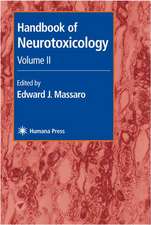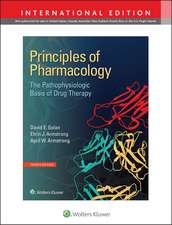Handbook of Copper Pharmacology and Toxicology
Editat de Edward J. Massaroen Limba Engleză Paperback – 5 noi 2010
| Toate formatele și edițiile | Preț | Express |
|---|---|---|
| Paperback (1) | 1343.78 lei 38-44 zile | |
| Humana Press Inc. – 5 noi 2010 | 1343.78 lei 38-44 zile | |
| Hardback (1) | 1452.86 lei 6-8 săpt. | |
| Humana Press Inc. – iul 2002 | 1452.86 lei 6-8 săpt. |
Preț: 1343.78 lei
Preț vechi: 1414.51 lei
-5% Nou
Puncte Express: 2016
Preț estimativ în valută:
257.21€ • 279.49$ • 216.20£
257.21€ • 279.49$ • 216.20£
Carte tipărită la comandă
Livrare economică 17-23 aprilie
Preluare comenzi: 021 569.72.76
Specificații
ISBN-13: 9781617372667
ISBN-10: 1617372668
Pagini: 628
Ilustrații: XVI, 608 p. 114 illus.
Dimensiuni: 178 x 254 x 33 mm
Greutate: 1.07 kg
Ediția:Softcover reprint of hardcover 1st ed. 2002
Editura: Humana Press Inc.
Colecția Humana
Locul publicării:Totowa, NJ, United States
ISBN-10: 1617372668
Pagini: 628
Ilustrații: XVI, 608 p. 114 illus.
Dimensiuni: 178 x 254 x 33 mm
Greutate: 1.07 kg
Ediția:Softcover reprint of hardcover 1st ed. 2002
Editura: Humana Press Inc.
Colecția Humana
Locul publicării:Totowa, NJ, United States
Public țintă
ResearchCuprins
I. Copper in Mammals.- 1 Biochemistry and Molecular Biology of Copper in Mammals.- II. Copper Proteins.- 2 Biochemistry of the Wilson’s Disease Protein.- 3 Biologically Relevant Properties of Copper-Containing Proteins Analyzed by Means of Semiquantitative and Quantitative Theoretical Descriptors.- 4 Molecular Modeling and Dynamics of Copper Proteins.- 5 The Prion Protein and Copper: What Is the Connection?.- 6 Prion Protein: A Synaptic Cuproprotein.- 7 Cytochrome-c Oxidase.- 8 The Fet3 Protein: A Multicopper Ferroxidase Essential to Iron Metabolism in Yeast.- 9 Interaction of Copper-Binding Proteins from Enterococcus hirae.- III. Copper Transport.- 10 Copper Uptake in Eukaryotic Cells.- 11 The Role of PINA in Copper Transport, Circadian Rhythms, and Wilson’s Disease.- 12 The Identification of Motifs Involved in the Intracellular Trafficking of the Menkes Disease Protein.- 13 Intracellular Copper Transport and ATP7B, the Wilson’s Disease Protein.- 14 A Multicopper Oxidase-Based Iron-Transport System in Yeast.- IV. Molecular Pathogenesis of Diseases of Copper Metabolism.- 15 Molecular Basis of Diseases of Copper Homeostasis.- 16 Disturbances of Copper Homeostasis and Brain Function.- 17 Role of Copper and Other Transition Metal Ions in the Pathogenesis of Parkinson’s Disease, Prion Diseases, Familial Amytrophic Lateral Sclerosis and Alzheimer’s Disease.- 18 Molecular Genetics and Clinical Aspects of Menkes Disease and Occipital Horn Syndrome.- 19 The Meaning of Alternative Transcripts of the Menkes Disease Gene.- 20 Expression Profiling in Menkes Disease.- 21 Regulation by Copper of the Expression of Human Bis, a New Gene Involved in the Cellular Stress Response to Metals.- 22 Non-Indian Childhood Cirrhosis: Using a Founder Population to Identify the UnderlyingGenetic Defect.- V. Copper Toxicity and Therapeutics.- 23 Biological Effects of Chronic Copper Exposure.- 24 Copper Toxicity to Tight Junctions in the Human Intestina Caco-2 Cell Line.- 25 Cellular Responses to Copper in Aquatic Organisms: Importance of Oxidative Stress and Alteration of Signal Transduction.- 26 Selective Removal of Copper Accumulating in the Form Bound to Metallothionein by Tetrathiomolybdate.- 27 Control of Copper in Wilson’s Disease and Diseases of Neovascularization, such as Cancer.- 28 Copper-Rich Metallothionein Polymers During the Development of Fulminant Hepatitis in LEC Rats: Effect of D-Penicillamine.- VI. Copper Metabolism and Homeostasis.- 29 Sensory Protein Modification: A New Feature in Copper Balancing.- 30 Comparative Analysis of Copper and Iron Metabolism in Photosynthetic Eukaryotes vs Yeast and Mammals.- 31 Copper and the Morphological Development of Streptomyces.- 32 Molecular Hardware of Copper Homeostasis in Enterococcus hirae.- 33 Copper Homeostasis in Plants.- 34 The Role of Copper Ions in Regulating Methane Monooxygenases in Methanotrophs.- 35 Regulatory Responses to Copper Ions in Fungi.
Recenzii
"...biochemical and molecular researchers from around the globe have produced 35 chapters documenting the present state of knowledge in selected areas of copper pharmacology and toxicology. the state-of-the-art data provided will no doubt stimulate challenging research with this essential trace element required by organism ranging from bacteria to mammals." - Veterinary and Human Toxicology
"The book has excellent introductory chapters, and summarizes much recent research at the genetic and cellular levels." - Newsletter of the British Toxicological Society
"Dr. Massaro must be congratulated for editing this comprehensive book on copper. There are so many outstanding chapters in this compendium that highlighting any one of them should not detract from the others...this book is a treasure trove of references. The price of the book, though modest for this compendium would be justified for the Preface and the first chapter alone. This book is highly recommended. At the present time it has no equal." -International Journal of Toxicology
"The book has excellent introductory chapters, and summarizes much recent research at the genetic and cellular levels." - Newsletter of the British Toxicological Society
"Dr. Massaro must be congratulated for editing this comprehensive book on copper. There are so many outstanding chapters in this compendium that highlighting any one of them should not detract from the others...this book is a treasure trove of references. The price of the book, though modest for this compendium would be justified for the Preface and the first chapter alone. This book is highly recommended. At the present time it has no equal." -International Journal of Toxicology
Textul de pe ultima copertă
Although copper is an essential trace element necessary for the survival of organisms ranging from bacteria to mammals, it is also highly toxic and must be absorbed by the body in precisely orchestrated biological processes. In Handbook of Copper Pharmacology and Toxicology, Edward J. Massaro and a panel of leading biomedical researchers and clinical practitioners review, in-depth, the status of our current knowledge concerning the biochemistry of copper in general, and its role in health and disease in particular. Drawing on the wealth of new information emerging from the molecular biology revolution, these experts survey the most important research areas of copper pharmacology and toxicology, including copper proteins and transport, copper toxicity and therapeutics, and copper metabolism and homeostasis. They also discuss the molecular pathogenesis of copper in a variety of metabolic diseases-Menkes and Wilson's diseases and occipital horn syndrome-as well as the role of copper in Parkinson's disease, prion disease, familial amyotrophic lateral sclerosis (ALS), and Alzheimer's disease. The elucidation of the precise mechanisms of copper trafficking, metabolism, and homeostasis will be of considerable importance in understanding the pathophysiology and treatment of such diseases.
Comprehensive and timely, the Handbook of Copper Pharmacology and Toxicology authoritatively provides researchers with all the up-to-date information needed to work productively in copper biology today.
Comprehensive and timely, the Handbook of Copper Pharmacology and Toxicology authoritatively provides researchers with all the up-to-date information needed to work productively in copper biology today.
Caracteristici
Includes supplementary material: sn.pub/extras















